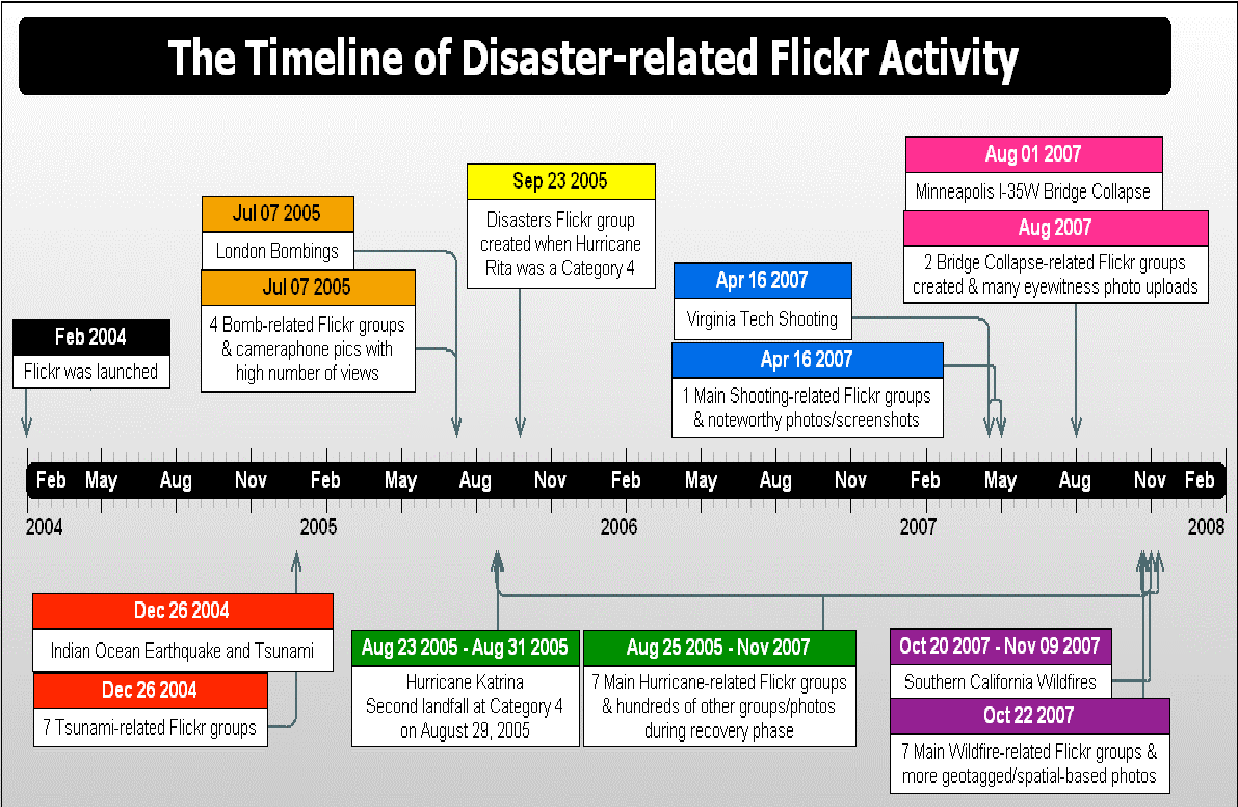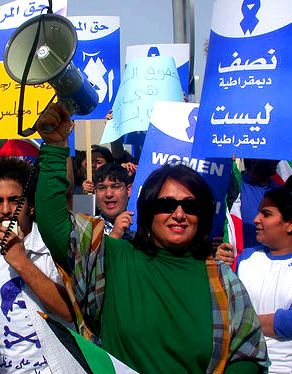Narrowing Down the Technology and the Sector
The purpose of this report is to outline the potential impact of the technology of photo-sharing on the sector of Non-Governmental Organizations (NGO). In the context of the present report, the technology is represented through Flickr, an online resource for photo-sharing and photo management. The focus of the report is on using photo-sharing in voluntary journalism and users participation in what constitutes the basic purpose of NGOs, which is relieving suffering, promoting the interests of the poor, protecting the environment, providing basic social services, or undertaking community development.
Photo-sharing, as the title implies, is the process of transferring digital photos by users online, and sharing them with the public or with selected users. Flickr as a representative of such technology is distinguished by two aspects, the focus on images only, rather than images adjacent to text as in other photo-sharing websites, and the method of sharing to the general public, through designating images as public (House, 2007). The metaphor for photo-sharing can be seen below.

My sector is non-governmental organizations and I have narrowed it down to Freedom House, a non –governmental organization based in Washington, D.C and it focuses on monitoring freedom and democracies all around the world (Freedom House, 2010a).
1301 Connecticut Avenue Building (AgnosticPreachersKid, 2010)
Freedom House is an organization founded in 1941 in the United States with the aim of monitoring and supporting freedom around the world. The first honorary co-chairpersons of the organization were Eleanor Roosevelt and Wendell Willkie. The main office of the organization is located in the United States, Washington D.C. with other offices in Hungary, Kenya, Indonesia, and other countries. As indicated in their mission statement, the organization accomplishes its objectives of supporting freedom around the world through analysis, advocacy and action. For the advocacy part, the organization operates through “public events, press releases, opinion articles, Congressional testimony and one-on-one meetings with policymakers” (Freedom House, 2010a).
The report will attempt to provide an analysis of the way the technology in photo-sharing can be beneficial for Freedom House in particular and the sector of NGOs in general, using the Intelligent Exploiter Framework (Holtham and Courtney, 2010).
Envisioning One Approach to the Scenario
The main business value that might arise from photo-sharing is multispeed transformation and change and costs reduction. The main focus in the activities of non-governmental organizations is tied to research and advocacy. In that regard, the analysis provided through text constitutes the largest aspect of their work, with photos taking the role of support. In that regard, the organization promotes itself as the leading source of information on the state of freedom worldwide and thus, response time to world events can be seen as vital in that matter. On the other hand, photo-sharing proved to be largely responsive in terms of posting photos representing certain global events. Taking the example of global disasters and recovery efforts, the Flickr community was found to be largely responsive, showing significant participation in such events. The utilization of the system will enable NGOs to eliminate the need for servers to store images, with all their photos being stored on Flickr servers. In five years, such technologies will eliminate the need for internal storage and databases, with all the works textual or visual being stored and processed in the “cloud” (Armbrust et al., 2010).

According to the aforementioned, it can be stated that photo-sharing as a technology can be considered as a commodity, rather than a strategic competitive advantage. The advantage provided by photo-sharing is neither new, nor it is vital for the context of NGOs’ missions and goals. Thus, borrowing the verdicts used by Nicholas Carr (2003) in “IT Doesn’t Matter”, it can be stated that photo-sharing will follow exactly the guidelines of IT for the future: cheap, homogenized, do not provide vulnerabilities essential for the business model (Carr, 2003).
Business Analysis

The influence of photo-sharing on the sector of NGOs can be understood through the knowledge and information dimension of the Intelligent Exploiter. According to such dimensions, the benefits of the technology can be seen through the main tasks of enterprises in such aspect, which is speeding up the creation of knowledge and accelerating its sharing across communities (Holtham and Courtney, 2010). With the latter being directly related to the activities of NGOs, namely Freedom House, in this case, the benefits that the NGO can utilize include the following:
- Eliminating the need to store the photos used in publications, reports and news on servers owned by the company. The collaboration between the researchers and photographers will be easier to conduct, considering any geographical disparities. Data might be collected on-site, while the text is written in another country, while the image obtained from Flickr. Such collaboration emphasizes that the images are used as a social narrative, a memory and an identity.
- Having more sources of photos of the same event for free emphasizes the neutrality of the organization. The organization might use the photos of a hired correspondent for the organization as well as photos from an ordinary citizen who was a witness of an event of a particular significance.
- Faster response time to publish a news report. People are encouraged to participate in sharing, and “Images tend to be posted quickly, of topics of immediate interest, significant and mundane (House, 2007).
Such benefits show that the knowledge emphasized in the organization is of organic nature, which makes the creation of the narratives of other people a useful means to communicate the objectives and the accomplishments of the organization. At the present time, it can be seen that such organization as Freedom House uses the results of the works of Flickr users in their news and reports, which provide all the aspects of the social uses of the technology. The narrative tells the story through the eyes of the user who uploaded the picture, the memory is stored on the website and the report in which it was published, and the identity of the user is indicated in the report as a contributor. An example of the latter can be seen through the example of a report on women’s rights in the Middle East and North Africa (Freedom House, 2010b). It can be seen through the report that the pictures of the report are provided by different contributors, all being users on Flickr (see Pic. 2).

In addition to providing their narration, their memories are stored and credit is given to their work. Accordingly, the use of such technology provided a befit lying within the goals and the mission of the organization.
References
Agnosticpreacherskid. 2010. 1301 Connecticut Avenue Building (Photo). Wikimedia Commons. Web.
Armbrust, M., Fox, A., Griffith, R., Joseph, A. D., Katz, R., Konwinski, A., Lee, G., Patterson, D., Rabkin, A., Stoica, I. & Zaharia, M. 2010. A View of Cloud Computing. Communications of the ACM, 53.
Carr, N. G. 2003. IT Doesn’t Matter. Harvard Business Review. Web.
Flickr. 2010. About Flickr. Web.
Graham, J. 2006. Flickr of idea on a gaming project led to photo website. Web.
Holtham, C. & Courtney, N. 2010. Intelligent Exploiter 2010, Cass Business School.
Freedom House. 2010a. Freedom House: About US. Web.
Freedom House. 2010b. Women’s Rights in the Middle East and North Africa. Web.
House, N. A. V. Flickr and Public Image-Sharing: Distant Closeness and Photo Exhibition.CHI ’07: CHI ’07 extended abstracts on Human factors in computing systems (2007). Web.
LIU, S. B., Palen, L., Sutton, J., Hughes, A. L. & Vieweg, S. 2008. In Search of the Bigger Picture: The Emergent Role of On-Line Photo Sharing in Times of Disaster. In: Fiedrich, F. & Walle, B. v. D. (eds.) The 5th International ISCRAM Conference. Washington, DC, USA.
Miller, A. D. & Edwards, W. K. 2007. Give and Take: A Study of Consumer Photo. CHI ’07: CHI ’07 extended abstracts on Human factors in computing systems. Web.
World Bank, L. 2007. NGO Research Guide. Web.